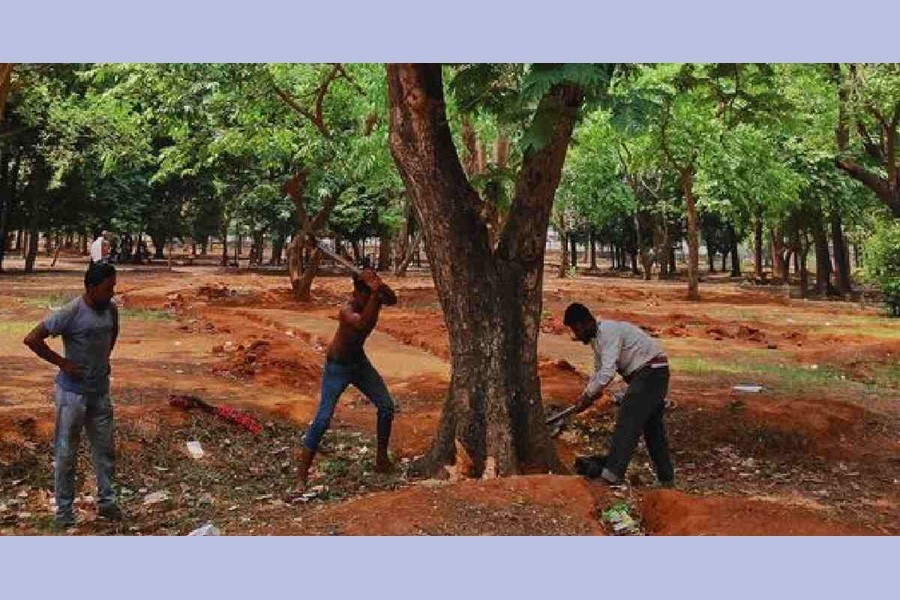The fascinating beauty of the densely grown trees and their thick foliage in the Ramna area has fascinated nature-lovers for ages. In the relatively modern times they include colonial British town planners, administrative people --- and even Bengalee writers living in Dhaka in the 1920s. Legendary Dhaka-lover Buddhadev Bose wasall-praise for the sylvan beauty of Dhaka, especially that of Ramna. It was reflected in his autobiographical essays and some short stories.
Half a century later, the architect of independent Bangladesh, Father of the Nation Bangabandhu Sheikh Mujibur Rahman was able to realise the need for utilisation of the vast greenery. A visionary leader as he was, he closed the then Ramna Race Course immediately after the country's independence. He ordered the Dhaka administration to turn the massive ground into a tree-filled public park --- 'udyan' in Bangla. In honour of the great Bengalee leader Huseyn Shaheed Suhrawardy, Bangabandhu named the former Race Course Suhrawardy Udyan. Saplings of large trees were plantedthroughout the ground. In a decade the 'udyan' was covered with small and semi-large trees. Eventually, it became an attractive venue for the Dhaka residents to pass their leisurely afternoons in the sprawling park. To the students of the adjacent Dhaka University, the 'udyan' emerged as a favourite haunt for gossiping under the shade trees.
The progress of the public park continued unabated. At the initiative of Prime Minister Sheikh Hasina's government in 1996, the authorities concerned began the work of an awe-inspiring 'stambha',an obelisk or glass-tower, as a memorial dedicated to the nation's independence. It was placed in the middle of a lagoon. Eventually, the area turned into an Independence Complex and declared open to public on March 7, 2011. As a prerequisite, the wide area witnessed the planting of trees of different types. It didn't take long for the spot to become a popular site for visits by the city people. On the national occasions, performances of musical sessions, plays etc became a regular feature at the Independence Complex.
Against this glorious backdrop, the indiscriminate felling of trees around the nationally important complex in the Udyan by a section of the authorities carries elements of puzzlement and absurdity. Of late, the tree-felling campaign at the public place of the Suhrawardy Udyan has whipped up spontaneous protests and condemnation from environmentalists and DU students. Defending the tree-felling measure, those in charge of the national installation have cited their ownreasons: they are engaged in the task of beautification of the site. According to them, they will construct fresh walkways to facilitate people's movement around the lagoon. The obelisk stands in its middle. As they view it, in accomplishing the task trees stand as impediments. So they have started clearing the 'unnecessary' trees.
According to the architects and town-planners involved with the original designing of the plan of the memorial, there were no provisions for felling trees near the installation. They suspect unauthorised changes were made to the original plan. The changed plan keeps the atrocious provision for felling trees. The action, in a way, is at variance with the government plan to bring the whole country under the internationally approved tree coverage. Since Bangladesh miserably falls behind the target, persons in the upper echelons of the government came forward. These days they are found engaged in urging people to plant trees in their localities. These appeals do not go unheeded. Sections of rural youths are seen nowadays getting engaged in social forestry.
The scenes are not unique in Bangladesh perspective. In the far-flung areas of the country, people both young and elderly are found spending their valuable time in keeping the two sides of local highways tree-lined. Apart from planting the saplings, they also have to guard the trees so that unscrupulous people cannot cause harm to the grown-up trees. Illegal tree felling in public places has long emerged as a common criminal practice also in the country's rural areas. In the past, the vice was limited to the cities and the suburbs.
The latest act of reckless and nonchalant felling of trees by some quarters is viewed by the sensible people in society in utter incredulity. The nation has no dearth of influential but insensitive elements in society. Their activities are ubiquitous. Few could think even remotely that these people could muster the audacious courage of clearing trees at the places near a national monument. One has to stretch his or her imagination to grasp the extent of power these people can wield to commit these acts and get away with them. It's now plain truth that these people enjoy the blessings of people who work as catalysts for these abominable acts. They pull the strings from behind for almost all such socially unacceptable works. In the Independence Memorial's tree-felling case, which distorts the natural beauty of the vast park, they may have gone too far without realising the act's grave consequences.
According to many in society, felling of trees in the Suhrawardy Udyan, dreamt of by Bangabandhu, and those grown near the Independence Memorial, amounts to demeaning the spirit of the Liberation War. The act is unconscionable.Meanwhile, the ongoing nationwide trend of clearing forests and felling trees to make space for different development infrastructure is set to invite doom for the country's environment. Its ecological balance is deteriorating fast, with signs of the climate change impacts becoming distinct. Placing anti-climate change proposals at global climate colloquiums may, thus, finally prove futile exercises.


